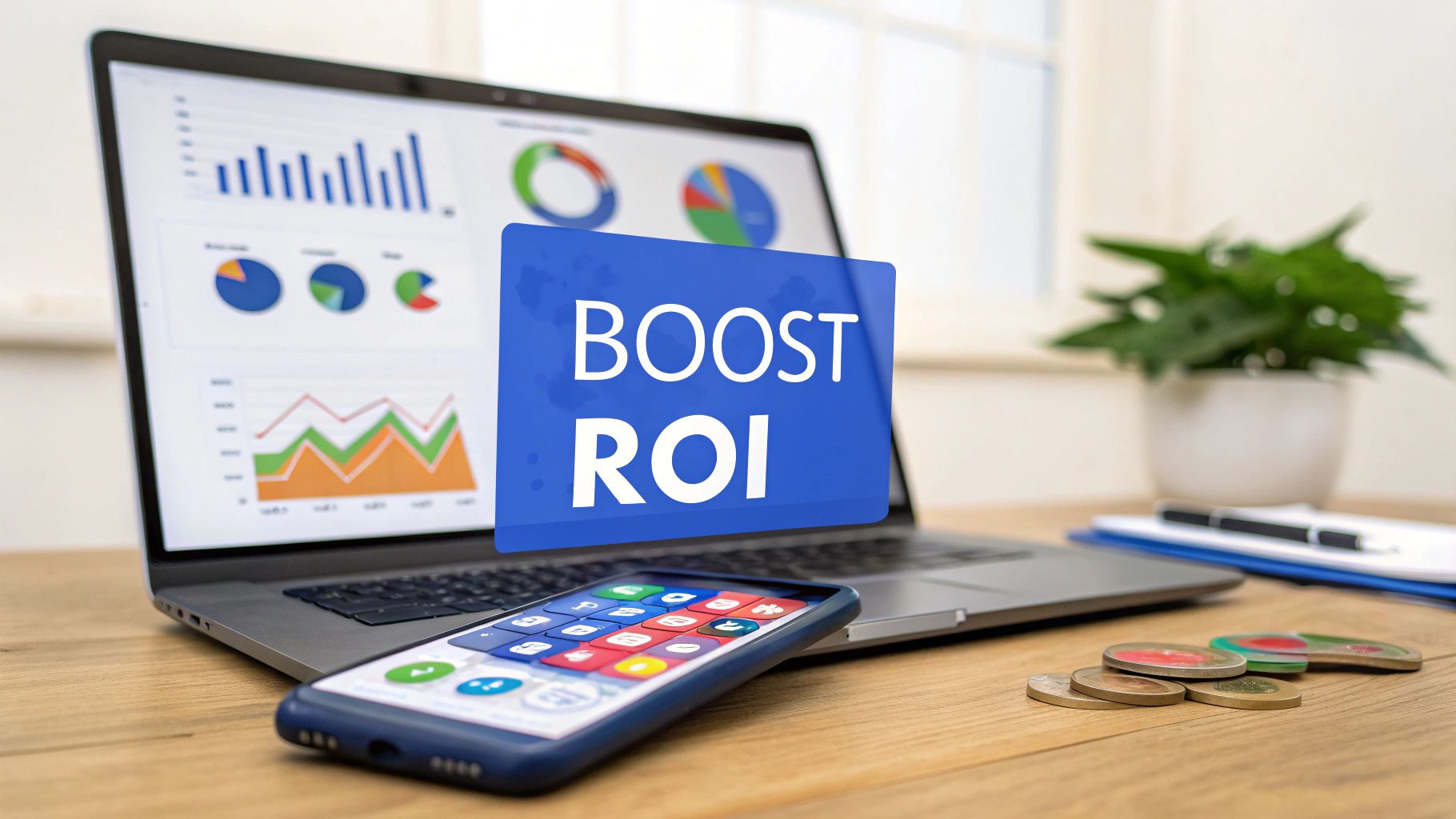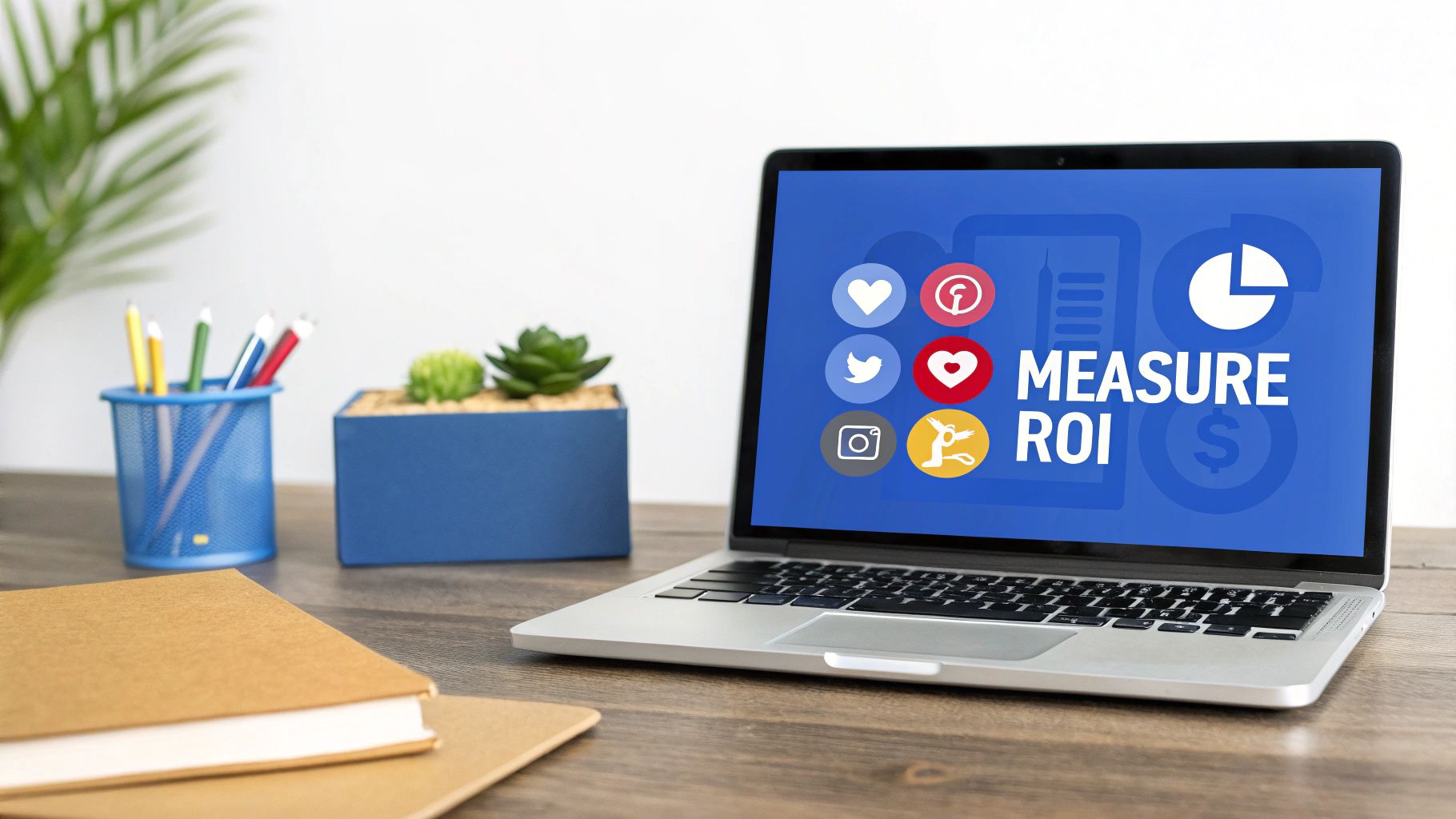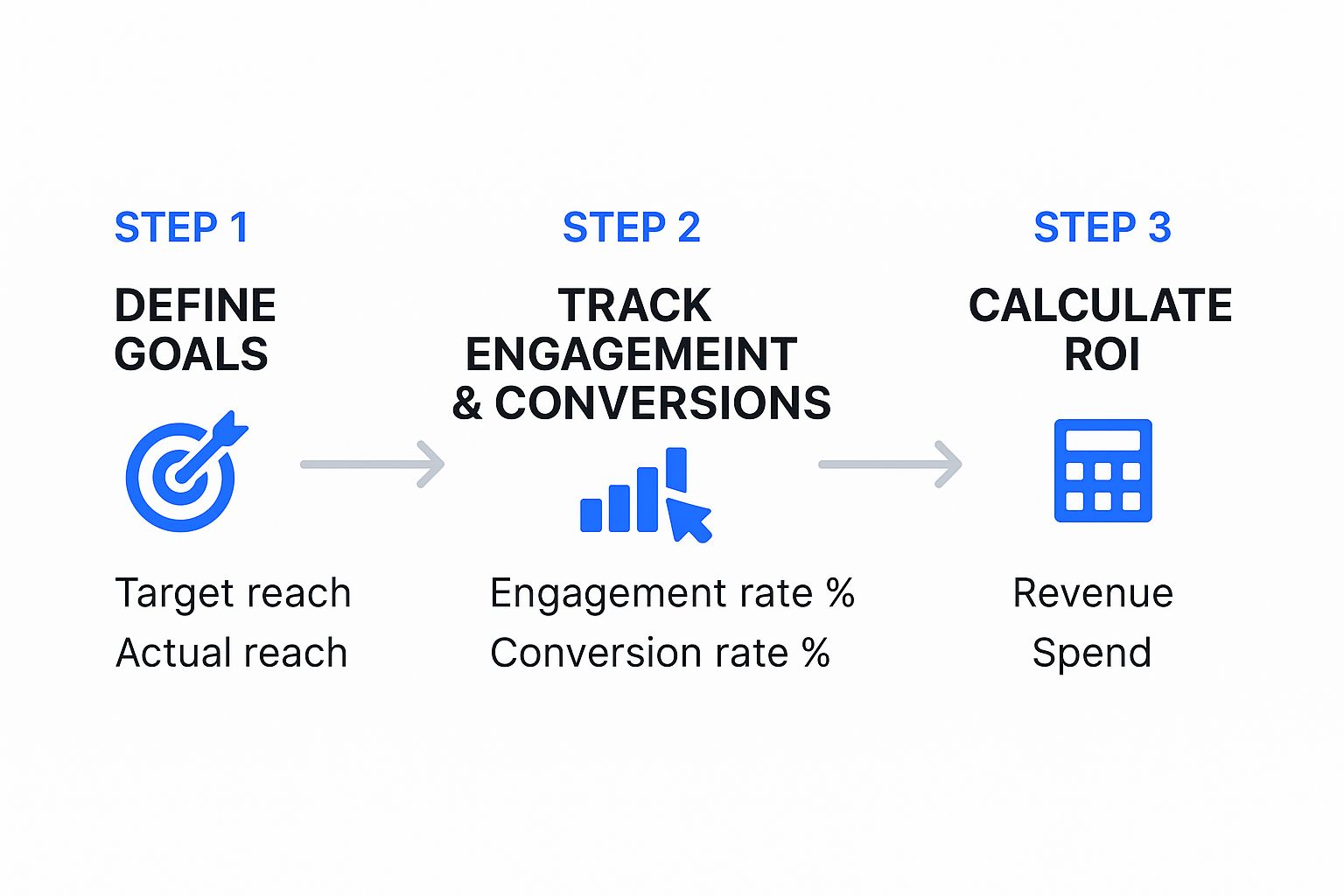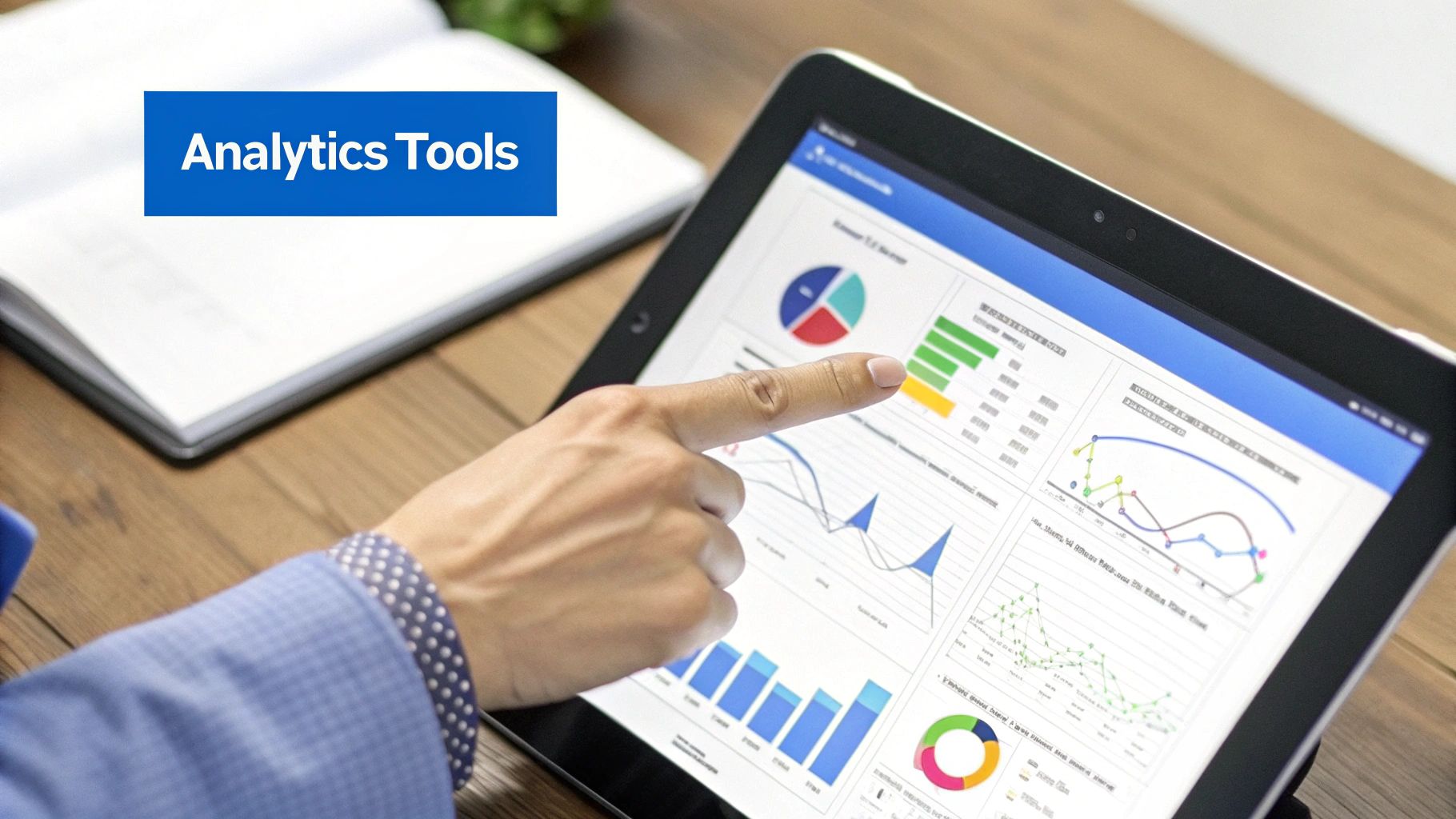Boost Your Social Media ROI with Proven Strategies
Learn how to measure and improve your social media ROI effectively. Discover actionable tips to maximize your social media marketing success.

Social media ROI, or Return on Investment, is just a way of measuring what you get back from all the work you put into social media. In simple terms, it answers the big question: is the time, money, and effort you're pouring into platforms like Instagram and TikTok actually paying off?
Why Social Media ROI Is Your Most Important Metric

Let's be honest, trying to justify your social media budget can sometimes feel like an uphill battle. You're putting out great content, your follower count is climbing, but the people holding the purse strings want to know one thing: what's the impact on the bottom line? This is where knowing your social media ROI becomes your secret weapon.
Think of your social media budget less like an expense and more like an investment in a promising stock. Your ROI report is what tells you whether that stock is soaring or starting to sink. A solid, positive ROI is the ultimate proof that your strategy is delivering real, measurable value.
From Cost Center to Revenue Driver
It's tough to ask for a bigger budget or know where to focus your efforts without hard numbers to back you up. But when you can confidently show a positive return, the whole conversation changes. All of a sudden, your social media team isn't just a "cost center" spending money on pretty posts; it's a proven revenue driver making a direct contribution to the business's success.
A firm grasp on ROI gives you the power to:
- Defend Your Budget: It's a lot easier to get your budget approved when you can show that for every dollar you spend on social, the company gets five dollars back.
- Make Smarter Bets: By seeing what’s actually working, you can go all-in on the platforms and campaigns that deliver the biggest punch, putting your resources where they matter most.
- Gain Strategic Influence: When you can prove your value with data, you earn a seat at the strategy table and get to influence bigger marketing and business decisions.
The pressure to prove ROI is real. In fact, a whopping 68% of marketers say they worry about showing the return from their social media efforts. If you can master this, you're already way ahead of the curve.
{{INTERN}}
Expanding the Definition of "Return"
Here’s the thing, though: the "return" in social media ROI isn't always about instant cash. While direct sales are a huge piece of the puzzle, you have to look at value in a more holistic way. The true impact often includes things that are less tangible but just as important. For a deeper dive into all the components, you can explore the full scope of a social media return on investment.
For example, a campaign might not result in a sale today, but it could build incredible brand loyalty that creates a high-value customer for years to come. Or maybe it generates a list of high-quality leads that the sales team can easily convert. These outcomes prove your social media strategy is building a foundation for long-term growth, not just chasing quick wins.
How to Confidently Calculate Your Social Media ROI
Let's be honest, "calculating social media ROI" can sound a bit intimidating. But it doesn't have to be. At its heart, it’s all about answering one simple question: Is the time, money, and effort we're pouring into social media actually paying off?
The basic formula is your best friend here. It’s clean, simple, and gives you a clear starting point.
Social Media ROI (%) = (Profit / Total Investment) x 100
This calculation gives you a straightforward percentage. If the number is above 0%, congratulations—you're making a profit. If it's in the negative, it’s not a failure; it’s a signal that your strategy needs a tune-up.
Defining Your Profit and Investment
To make this formula work for you, you have to get crystal clear on what "profit" and "investment" actually mean for your business. This isn't a one-size-fits-all thing.
Profit is the cold, hard cash your social media efforts bring in. This is the most direct measure of your return, usually coming from sales you can trace directly back to your social channels.
Investment, on the other hand, is every single penny you spend to make your social media happen. And I mean everything. It’s way more than just your ad budget.
Your total investment needs to cover:
- Ad Spend: The money you're putting into paid campaigns on all your platforms.
- Content Creation: The cost of any graphic design, video shoots, photography, or copywriting.
- Software and Tools: Those monthly subscription fees for your scheduling, analytics, and management tools add up.
- Team Hours: The salaries (or hourly rates) of your social media manager, content creators, or anyone else involved, calculated for the time they spend on social media tasks.
Getting a handle on these numbers is the difference between guessing and knowing. This visual breaks down how your goals and actions all flow into that final ROI calculation.

As you can see, figuring out your ROI is the last piece of the puzzle. It all starts with setting clear goals and tracking your performance every step of the way.
Putting the ROI Formula into Practice
Let's make this real. Imagine a small e-commerce brand selling handmade jewelry. They decide to run a targeted Instagram campaign for a new collection.
Here’s how they'd break down the numbers:
- Calculate Total Investment:
- Instagram Ad Spend: $1,000
- Content Creation (photoshoot): $500
- Social Media Manager's Time (estimated): $500
- Total Investment: $2,000
- Calculate Total Profit:
- By using UTM tracking links in their ads and posts, they can attribute $5,000 in sales directly to the campaign. This is their profit.
- Calculate the ROI:
- First, find the net profit: $5,000 (Profit) - $2,000 (Investment) = $3,000
- Now, use the formula: ($3,000 / $2,000) x 100
- ROI = 150%
- Vanity Metrics: This group includes followers, likes, and impressions. They show reach and surface-level interest, but they don't directly correlate to revenue. A post can get thousands of likes without generating a single sale.
- Actionable Metrics: These are the numbers that prove your audience is taking a step closer to becoming a customer. They include things like click-through rates, conversion rates, leads generated, and, of course, sales revenue.
- Click-Through Rate (CTR): This measures the percentage of people who saw your post and clicked the link. A high CTR is a strong signal that your content is compelling enough to spark action.
- Conversion Rate: This is the percentage of users who clicked your link and then completed a specific goal, like making a purchase or signing up for a newsletter. This is a direct measure of your campaign's real-world effectiveness.
- Cost Per Lead (CPL): For B2B or service-based businesses, this is absolutely crucial. It calculates exactly how much you spent on social media to acquire one new lead.
- Cost Per Acquisition (CPA): This takes it a step further by measuring the total cost to acquire a paying customer through your social channels.
- Find the Average Purchase Value: On average, how much does a customer spend per order?
- Determine Purchase Frequency: How many times a year does an average customer buy from you?
- Estimate Customer Lifespan: How many years do customers usually stick around?
- First, find your average cost-per-click (CPC) from your paid campaigns.
- Next, track the number of clicks your organic social posts drive to your website each month.
- Finally, multiply the number of organic clicks by your average CPC.
- Ad Creative: Pit a video against a static image. Or try a polished, professional photo against a more authentic, user-generated-style shot.
- Ad Copy: Experiment with different headlines. Does asking a question work better than making a bold statement? Does long-form copy outperform a short, punchy sentence?
- Call-to-Action (CTA): See if "Shop Now" converts better than "Learn More." Sometimes a tiny change in wording can make a huge difference.
- Improve Customer Service: Quickly jump on complaints before they escalate into bigger problems.
- Innovate Products: See what features your customers are practically begging for.
- Refine Messaging: Understand the exact language your audience uses, so you can speak their language.
- Product Launches: Calculate your ROI as soon as the launch campaign is over. You need to know if that specific push was a success on its own.
- Holiday Sales: Measure the return the moment the promotion ends. This is crucial intel for planning next year's strategy.
- Targeted Ad Campaigns: Review the ROI right after the ad set finishes. Was it worth the spend? The numbers will tell you.
- A fast-fashion brand with thin margins might need a 10:1 ratio just to be profitable after factoring in the cost of their products.
- A high-margin SaaS company, on the other hand, could be thrilled with a 3:1 ratio if that investment lands them a loyal customer who pays a subscription for years.
- Are my ad costs out of control? If your cost-per-click is through the roof, it’s time to A/B test new creatives, tighten up your audience targeting, or tweak your bidding strategy.
- Is my engagement dead in the water? If nobody is liking, commenting, or sharing, your content probably isn't hitting the mark. Dig into whether your posts actually solve a problem or spark joy for your audience. For a deeper dive, our guide on how to measure social media engagement has some great tips.
- Am I driving traffic that doesn't convert? If you're getting plenty of clicks but no sales, the issue might not be your social media at all—it could be your landing page. Check the page speed, the user experience, and whether your call-to-action is clear and compelling.
A 150% ROI is fantastic. It means for every single dollar they put into that campaign, they got that dollar back plus an extra $1.50 in pure profit. That's not just a good feeling—it's a clear signal that the campaign was a huge success.
As your campaigns get bigger and more complex, using a dedicated Social Media ROI Calculator can be a lifesaver. It simplifies the math and helps you stay accurate. This is how you move from just hoping your social media is working to knowing its exact contribution to your bottom line.
Tracking the Metrics That Actually Matter for ROI

It's easy to get a rush from a climbing follower count. But let's be honest—that's what we call a vanity metric. It looks fantastic on the surface but doesn't actually pay the bills. To get a real grip on your social media ROI, you have to look past the ego-boosters and zero in on the data that signals a genuine business impact.
Think of yourself as the coach of a sports team. The number of fans cheering in the stands is great for morale, but it's the score on the board that determines if you win or lose. Your job is to track the numbers that put points on the board for your business.
This all comes down to separating the feel-good stats from the metrics that plug directly into your ROI calculation. You need to draw a clear, undeniable line from a specific social media action—like a single Tweet or a TikTok video—to a tangible business outcome, like a sale or a qualified lead.
{{INTERN}}
Differentiating Vanity from Value
The first real step is learning to spot the difference between metrics that stroke your ego and those that actually drive your strategy forward. While things like likes and followers have their place in gauging brand awareness, they rarely tell the whole story of your financial return.
The real game-changer is connecting your social activity to your bottom line. Actionable metrics are the bridge that allows you to confidently say, "Our Instagram story from Tuesday generated $500 in sales," instead of just, "It got a lot of views."
Mastering Conversion Metrics
When it comes to measuring social media ROI, conversion metrics are the gold standard. Why? Because they track the actions that lead directly to profit. They answer the most important question of all: are people actually doing what we want them to do?
Here are the essential conversion metrics you should be watching like a hawk:
Tracking these numbers gives you a crystal-clear financial picture. If your CPA is lower than the average lifetime value of a customer, you can officially say your social media strategy is profitable. It's that simple.
To make this easier, we've organized the most important metrics into a table. This will help you see exactly what you should be tracking based on your specific business goals.
Pro tip: Want to know if your audience is truly engaged, not just scrolling past? Try our free Instagram Engagement Rate Calculator. In seconds, you’ll see how your content performs against industry benchmarks, giving you a clearer view of whether your social media efforts are paying off.
Essential Social Media Metrics for ROI Analysis
By selecting metrics that align with your core objectives, you move from simply being on social media to using it as a powerful, measurable engine for business growth.
The Power of Tracking Tools
You can't track what you can't see. Plain and simple. To get this kind of granular data, you need the right tools in your arsenal. This is where you stop guessing and start making data-driven decisions that directly improve your ROI.
One of the most powerful—and surprisingly accessible—tools is the UTM parameter. These are just simple snippets of code you add to the end of a URL. They tell your analytics software exactly where a visitor came from. For example, you can create a unique UTM link for a specific Facebook ad, allowing you to see precisely how many clicks, leads, and sales that single ad generated.
Platform-native analytics, like Meta Business Suite or TikTok Ads Manager, are also invaluable. They provide deep insights into ad performance, audience demographics, and conversion events. The key is to actually use these tools to their full potential, not just glance at the dashboard.
The difference in confidence is striking. Marketers who use advanced analytics and social listening tools report being far more certain about their ROI. For example, a whopping 67% of Facebook marketers who use these tools feel assured in their marketing spend, compared to just 27% who do not. To get a better sense of this, you can explore the full social media statistics.
Putting a Price Tag on Clicks and Engagement

How much is a ‘like’ or a ‘share’ really worth? This is where so many marketers get bogged down when trying to calculate their social media ROI. Sure, direct sales are easy enough to track. But the real, lasting value of your social media efforts often comes from actions that don't immediately ring the cash register.
The secret is to assign a tangible dollar value to these seemingly fuzzy engagements. It’s the only way to see the full picture.
Think of it like this: every social media post is a seed. Not every single one will sprout into a money tree overnight. But many will grow into valuable assets—things like web traffic, brand mentions, and the kind of long-term customer relationships that build an empire. To prove your garden is thriving, you need a way to value every sprout, not just the final harvest.
This process is how you turn abstract metrics into hard numbers for your ROI report. Let’s break down three practical ways to do exactly that.
Calculating Customer Lifetime Value from Social
One of the most powerful ways to measure your return is to look far beyond a single purchase. A customer who comes from a Facebook ad might only spend $50 today. But what happens if they love your brand and come back every month for the next three years? Suddenly, that initial $50 sale represents thousands in future revenue.
That's Customer Lifetime Value (LTV), and it's a game-changer.
Calculating LTV turns a one-time win into a long-term strategic asset. Here’s a simplified way to figure it out:
Multiply those three figures, and you have a solid estimate of a customer's LTV. Once you can show that customers from social media have a high LTV, you can confidently justify spending more to acquire them, knowing the long-term payoff is huge.
By focusing on LTV, you shift the conversation from, "How much did this campaign make?" to, "How valuable are the customers this campaign brought us?" It’s a subtle but critical change that highlights the true, long-term impact of your social media.
Valuing Your Organic Web Traffic
Every single person who clicks a link in your bio or an organic post is a win. But how do you put a number on that? An easy and effective way is to compare it to what that same traffic would have cost you through paid ads.
This is what we call Paid Advertising Equivalency. Think about it: if you didn't get that click from your organic Instagram post, you might have had to pay for it through Google Ads or Facebook Ads. By earning it for free, you’ve created real, measurable value.
Here’s how to calculate it:
For instance, if your average CPC is $2.00 and your organic posts generated 1,000 clicks this month, you've essentially created $2,000 in value. That’s a real number you can plug right into the "Return" side of your social media ROI equation.
Measuring the Worth of Earned Media
Earned media is any mention, share, or user-generated content you didn't pay for. It’s gold. When a happy customer posts a glowing review or a popular blogger features your product, that's incredibly valuable exposure. Just like with traffic, you can assign a dollar value by calculating its paid equivalent.
Look at the reach of that user's post. If an influencer with 50,000 followers shares your product, you can estimate what it would have cost to reach a similar-sized audience with paid ads. Just use your own campaign data, like your average cost-per-thousand-impressions (CPM), to make a solid estimate.
If your average CPM is $10, that single influencer post generating 50,000 impressions is worth roughly $500 in advertising value. This method gives you a concrete way to quantify the buzz around your brand, turning fuzzy engagement into a hard number for your ROI analysis.
Actionable Strategies to Boost Your Social Media ROI
Knowing your social media ROI is a fantastic start, but the real goal is to make that number grow consistently. Simply measuring your return isn't enough; you need a playbook for turning those insights into action and, ultimately, more profit. This is where you move from observer to strategist, actively shaping your results.
Let's dive into the powerful, practical strategies that will transform your social media presence from a cost center into a reliable revenue engine. These aren't abstract theories but proven tactics designed to give you a better return for every dollar and hour you invest.
Relentlessly A/B Test Your Ads
One of the quickest ways to improve your social media ROI is to slash your customer acquisition costs. The best way to do that? Relentless A/B testing. Think of it as a scientific experiment for your marketing. Instead of launching one ad and just hoping for the best, you run multiple versions to see which one actually gets results.
You can test nearly anything, but it’s smart to start with the elements that have the biggest impact:
By systematically testing and redirecting your budget to the winning variations, you stop wasting money on underperforming ads. You ensure every dollar is working as hard as possible. If you want to master this, our guide on how to do Instagram ads provides a great foundation for building effective campaigns.
Leverage User-Generated Content
Why spend a fortune on expensive photoshoots when your happiest customers are creating high-quality, authentic content for free? User-generated content (UGC) is any content—photos, videos, reviews, testimonials—created by real users rather than your brand. It’s one of the most powerful assets you have for boosting ROI.
UGC builds incredible trust. A staggering 79% of people say that user-generated content highly impacts their purchasing decisions, far more than brand-produced content or even influencer posts.
Incorporating UGC into your strategy does two major things for your ROI. First, it dramatically cuts down on your content production expenses. Second, its authenticity and social proof almost always lead to higher conversion rates than slick, polished brand assets. Encourage customers to share their experiences using a unique hashtag, and then feature the best posts on your feed (with permission, of course).
Harness the Power of Social Listening
What if you could spot emerging market trends, identify customer pain points, and discover new product ideas before your competitors even know what’s happening? That’s the immense value of social listening. It’s the simple act of monitoring social media channels for mentions of your brand, your competitors, and relevant keywords.
Social listening delivers a high ROI by giving you invaluable market intelligence. It helps you:
By tuning into these conversations, you can make smarter, more informed decisions that lead directly to better products and more effective marketing. All of which fuel a higher ROI. For insights into how specific industries apply these tactics, check out these social media marketing strategies for musicians, which show how listening to fan feedback can shape a successful career.
Shorten the Path to Purchase with Social Commerce
Every extra click or page load between a customer seeing your product and being able to buy it is a chance for them to lose interest and walk away. The most effective way to boost your sales ROI is to shorten that path as much as you possibly can. This is where social commerce comes in.
Social commerce transforms your feed from a simple gallery into a direct and powerful sales tool. Features like shoppable posts on Instagram or TikTok Shop let users browse and purchase products without ever leaving the app. This seamless experience dramatically reduces friction and is perfect for capturing those impulse buys.
The impact of this shift is undeniable. Social networks now account for a significant 17.11% of all global online sales, a figure that highlights their transformation into robust sales channels. By simply making it easier for people to buy, you directly improve your social media ROI.
Your Social Media ROI Questions Answered
Alright, so you’ve got the formula down and you know which metrics to track. But let's be real—applying social media ROI theory to your actual, day-to-day business is where things get tricky. It’s one thing to know the 'what,' but the 'how' and 'how often' are where most marketers get stuck.
This is where we move past the textbook definitions and get into the practical stuff. Below are the no-fluff answers to the most common questions that pop up, the ones that can make or break your ability to prove your social media is actually working.
How Often Should I Calculate My Social Media ROI?
There’s no magic, one-size-fits-all answer here. The right rhythm really depends on your business and the kinds of campaigns you're running. The goal is to find a cadence that gives you real insights without making you panic over normal, everyday blips in performance.
For your general, always-on social media—your daily posts, community chatter, and brand building—a monthly or quarterly review is the sweet spot. This gives you enough data to see real trends emerge. If you calculate it daily or weekly, you risk making knee-jerk decisions based on a tiny, incomplete snapshot of data.
But for specific, time-sensitive campaigns, the rules change:
Ultimately, you want to build a consistent reporting schedule that lines up with your strategic planning. This turns ROI from a dreaded task into a powerful, ongoing tool for making smarter decisions.
{{INTERN}}
What Is a Good ROI for Social Media?
This is the million-dollar question, isn't it? The honest answer is that there’s no universal number. You might hear people throw around a 5:1 ratio ($5 in return for every $1 spent) as a solid benchmark, but that number is totally dependent on your industry, business model, and—most critically—your profit margins.
Think about it this way:
The only benchmark that truly matters is your own. Your first step is to figure out your current, baseline ROI. From there, your one and only goal should be to improve it, month after month. Focus on beating your past performance, not some generic industry standard.
What Should I Do If My Social Media ROI Is Negative?
First off, a negative ROI isn't a sign of failure. It's a flashing red light telling you that your current strategy needs a tune-up. Seeing a negative number can sting, but it’s actually incredibly useful data for figuring out what’s broken.
So, don't panic. Start by double-checking all your numbers. Make sure your tracking is set up correctly and you haven't made a simple miscalculation. If the numbers hold up, it’s time to play detective and find the "why."
Ask yourself these questions:
Treat a negative ROI as an opportunity. Isolate one variable, test a change, and see what happens. This methodical approach is the fastest way to get back in the green.
Ready to stop guessing and start growing? At BoostFluence, we provide the tools and expertise you need to turn your social media presence into a powerful engine for growth. From boosting engagement to managing your content, we help you achieve a social media ROI you can be proud of. Discover how BoostFluence can elevate your Instagram strategy today.
Want to Grow Your Instagram?
Use BoostFluence tools to grow your followers, engagement, and authority — for ambitious agencies, businesses and creators.



Get More Instagram Followers
Reach your target audience and grow your followers with interactive campaigns.

Swipe Up to Get More Followers!

Get More Instagram Followers
Reach your target audience and grow your followers with interactive campaigns.




